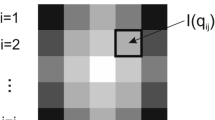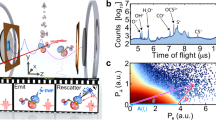Abstract
THE Born approximation for the electron wave scattered by an atom has been universally employed for the interpretation of electron diffraction experiments directed toward the determination of molecular or crystal structure. There is some justification for this. Quantitative measurements of diffraction intensities performed to test the applicability of the approximation for electrons of the energies usually used in structure work have, on the whole, been regarded as satisfactory verifications. In structure work itself—in the work on gas molecules, for example—the considerable success resulting from it use has led to the feeling that even in the presence of heavy atoms there might not be serious error. There has perhaps been the implicit faith that whatever theoretical refinements were lacking would at least not alter substantially the structures to be derived. We have found, however, that there is a phase shift on scattering, not given by the first Born approximation (this is the familiar Born approximation, the first term of a power-series expansion in the parameter α = − Ze2/hv), which is approximately proportional to atomic number, depends on angle of scattering, and may become large and important. The suggestion of the existence of this phase shift arose from the cases of uranium hexafluoride (UF6) and some other gas molecules.
This is a preview of subscription content, access via your institution
Access options
Subscribe to this journal
Receive 51 print issues and online access
$199.00 per year
only $3.90 per issue
Buy this article
- Purchase on Springer Link
- Instant access to full article PDF
Prices may be subject to local taxes which are calculated during checkout
Similar content being viewed by others
References
Braune, H., and Pinnow, P., Z. phys. Chem., B, 35, 239 (1937). Bauer, S. H., J. Chem. Phys., 18, 27 (1950). The observations have been checked in these laboratories by Dr. O. Bastiansen.
See especially Bigeleisen, J., Mayer, M. G., Stevenson, P. C., and Turkevich, J., J. Chem. Phys., 16, 442 (1948) and Burke, T. G., Smith, D. F., and Nielsen, A. H., J. Chem. Phys., 20, 447 (1952).
Germer, L. H., Phys. Rev., 56, 58 (1939).
Yearian, H. J., Phys. Rev., 48, 631 (1935).
Acta Cryst., 3, 314 (1950).
Acta Cryst., 3, 479 (1950).
Author information
Authors and Affiliations
Rights and permissions
About this article
Cite this article
SCHOMAKER, V., GLAUBER, R. The Born Approximation in Electron Diffraction. Nature 170, 290–291 (1952). https://doi.org/10.1038/170290b0
Issue Date:
DOI: https://doi.org/10.1038/170290b0
This article is cited by
-
A personal history of structural chemistry
Structural Chemistry (2015)
-
Straying From the Beaten Path, and Other Stories About Molecules
Structural Chemistry (2005)
-
Calculation of multiple many-center electron scattering by molecules in the Glauber approximation
Journal of Structural Chemistry (1974)
-
Accounting for nonnuclear scattering in the born approximation
Journal of Structural Chemistry (1970)
-
Effect of some experimental errors upon the curve of the radial distribution of atoms
Journal of Structural Chemistry (1968)
Comments
By submitting a comment you agree to abide by our Terms and Community Guidelines. If you find something abusive or that does not comply with our terms or guidelines please flag it as inappropriate.



